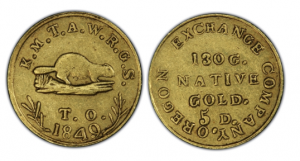The Renegade Businessman Behind Oregon’s Gold Beaver Coins
Posted onDuring the 1848 California gold rush, many Oregon settlers headed south to join the fray, seeking their fortunes. Some found success in the California gold mines and returned home to the Oregon Territory with bags of gold dust. Yet, as in other Western territories, conducting commerce in gold dust created a lack of uniformity for simple everyday purchases. Gold dust was also easily contaminated and subject to fraud.
During this time, items like beaver skins, wheat, gold dust, and silver coins from Mexico and Peru were used in everyday commerce, because of a lack of standard coinage. All these items were of ever-changing and uncertain value for those making the trades. Beaver skins and wheat were also difficult to transport and vulnerable to damage, making them an unstable medium of exchange.
A standard coin system was sorely needed.
In February 1849, the Oregon Territorial Legislature passed an act authorizing the creation of $5 and $10 gold coins. However, right at this time, Oregon joined the United States as an official territory and the new governor declared the Coinage Act unconstitutional.
Since both the Federal and Territorial governments failed to create a desperately needed standardized currency, eight entrepreneurial Oregon businessmen seized the opportunity and started a private mint they called the Oregon Exchange Company.
Essentially, these eight businessman struck solid gold coins without government permission. They produced gold coins in $5 and $10 denominations, known today as Beaver coins, named for the furry mammal’s likeness featured on the obverse of the coin. Later, the beaver became the official emblem of Oregon.
The eight businessmen who founded the Oregon Exchange added their initials to the obverse of the coin. The initials O.T. or T.O., for Oregon Territory, and the date are also seen on the obverse design. Today, you can see dies for these historical beauties at the Oregon Historical Society in Portland.
During this moment in Oregon history, gold Beaver coins filled a need to smooth daily financial transactions. The Oregon Exchange company’s coins, produced with virgin gold, were quickly recognized as trustworthy currency as the minters struck their coin’s weight above federal norms. Also, the gold for the Beaver coins was not artificially alloyed with silver or copper, so there was no question regarding its value in commerce.
Commercial trade and activity in the Oregon Territory was greatly augmented with the minting of the new, standardized gold Beaver coins, as it was no longer necessary to transport items like wagons of wheat or beaver skins from place to place to use as mediums of exchange.
But the life of this legendary Oregon mint was short. Before the Oregon Exchange Company stopped its operations in September 1849, it had minted California gold into roughly 6,000 $5 coins and 2,850 $10 coins. Once the U.S. Mint opened in San Francisco in 1854, the government mandated that all private territorial coinage be turned in and melted down.
A few Beaver coins escaped the melting pot, and about 50 of these unique coins from an exciting era in U.S. history are believed to exist today. Beaver gold coins rarely surface for sale and remain one of the most sought-after and unique territorial coins ever minted.
Want to read more? Subscribe to the Blanchard Newsletter and get our tales from the vault, our favorite stories from around the world, and the latest tangible assets news delivered to your inbox weekly.









